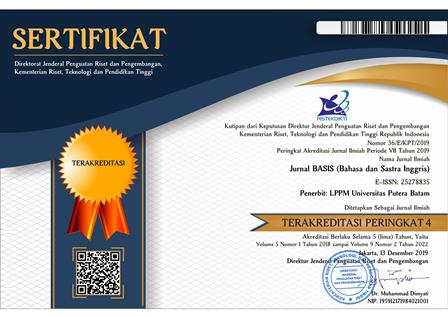English
DOI:
https://doi.org/10.33884/basisupb.v9i2.5626Abstrak
Abstrak
Penelitian ini membahas tentang dekonstruksi kematian dalam “In Memoriam” yang ditulis oleh Alfred Lord Tennyson. Penulis menerapkan Teori Dekonstruksi untuk mendekonstruksi kematian adalah pengalaman menakutkan bagi humas sebagai makna terpusat untuk “In Memoriam”. Hasil dari pembacaan dekonstruksi adalah ditemukannya “makna lain”, penulis menemukan kematian adalah awal dari keabadian. “Makna lain” ini berhasil menyanggah posisi makna terpusat dalam “In Memoriam”.
Keyword: Kematian, Dekonstruksi, Alfred Lord Tennyson, In Memoriam
Referensi
Al-Jumaily, A. S. H. (2017). A Deconstructive Study in Robert Frost’s Poem: The Road Not Taken. Journal of Literature, Language, and Linguistics, 33, 16-22. https://iiste.org/Journals/index.php/JLLL/article/view/36633
Aprilia, C. & Arianto, T. (2021). Binary Oppositions as The Result of Deconstruction Analysis in The Goldfinch Novel by Donna Tart. Journal Basis: Jurnal Bahasa dan Sastra Inggris Universitas Putera Batam, 8(1), 65 – 74. https://doi.org/10.33884/basisupb.v8i1.2812
Bodgan, R. C. & Sari, B. K. (2007). Qualitative Research for Education. Allyn and Bacon, Inc.
Bowta, F. & Puluhulawa, Y. (2018). Deconstructive Analysis of Main Character in
Frankenstein Novel by Mery Shelley. British: Journal Bahasa dan Sastra Inggris, 8(2), 60 – 71. https://dx.doi.org/10.31314/british.7.1.60-71.2018
Bradley, A. (2008). Derrida’s Of Grammatology: An Edinburgh Philosophical Guide. Edinburgh University Press.
Derrida, J. (1976). Of Grammatology. The John Hopkins University Press.
Hill, L. (2007). The Cambridge Introduction to Jacques Derrida. Cambridge University Press.
Howard, J. (2010). Tennyson’s In Memoriam. The Explicator, 68(4), 231-234. https://doi.org/10.1080/00144940.1954.11481736
Royle, N. (2003). Jacques Derrida. Routledge.
Taylor, M. M. (1971). Symbol and Mood in Tennyson’s Nature Poetry. Master Thesis, University of Richmond.
Shrivastwa, B. K. (2020). Deconstructive Reading of Dylan Thomas’s Poems Contemporary Literary Review India, 7(2), 81-89. https://doi.org:10.201411/clri.v7i4.514
Tennyson, A. L. (1850). In Memoriam. The Riverside Press Cambridge
Ungkang, M. (2013). Dekonstruksi Jaques Derrida sebagai Strategi Pembacaan Teks Sastra. Jurnal Pendidikan Humaniora, 1(1), 30-37.http://journal.um.ac.id/index.php/jph/article/view/3919
Widyahening, C. E. T., & Wardhani, N. E. (2021). Deconstruction of maleficent characters in the movie titled ’Maleficent’. Linguistics and Culture Review, 5(S3), 1453-1467.https://doi.org/10.21744/lingcure.v5nS3.1681

















